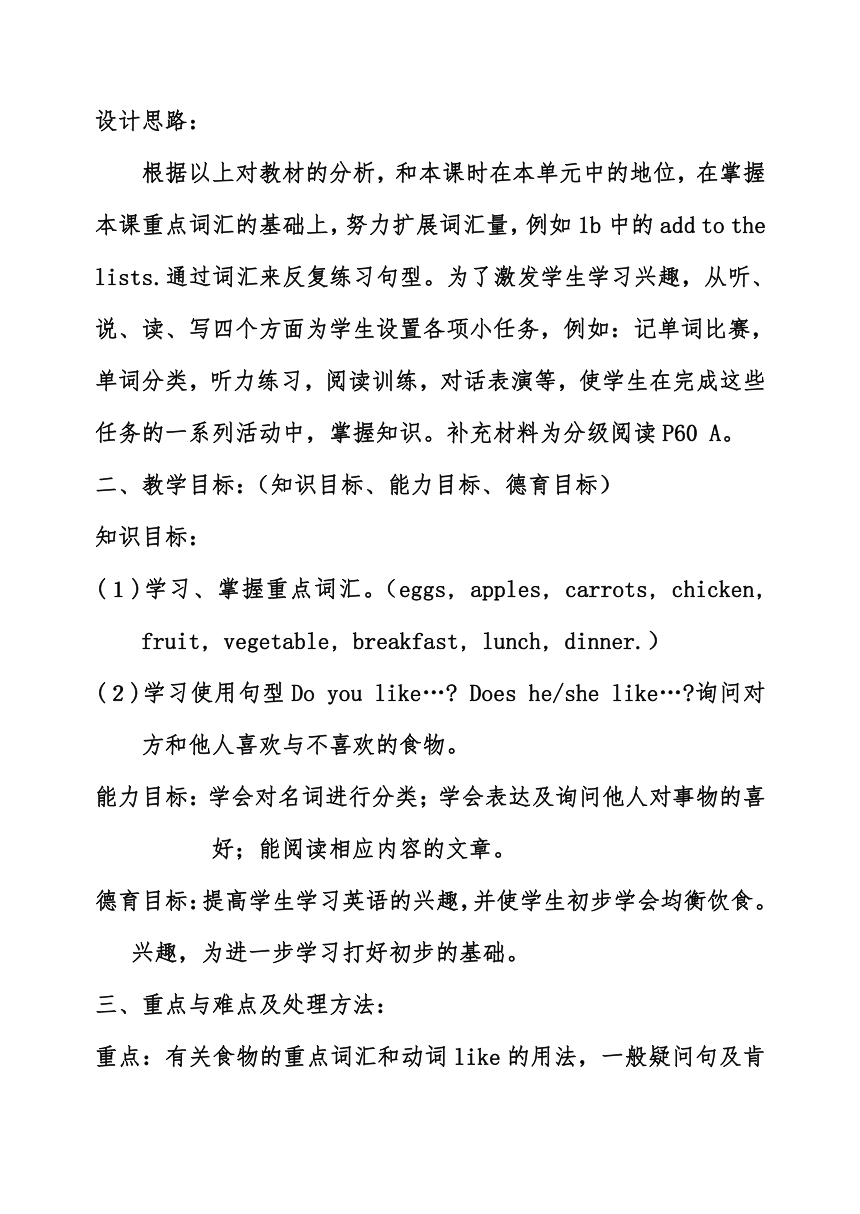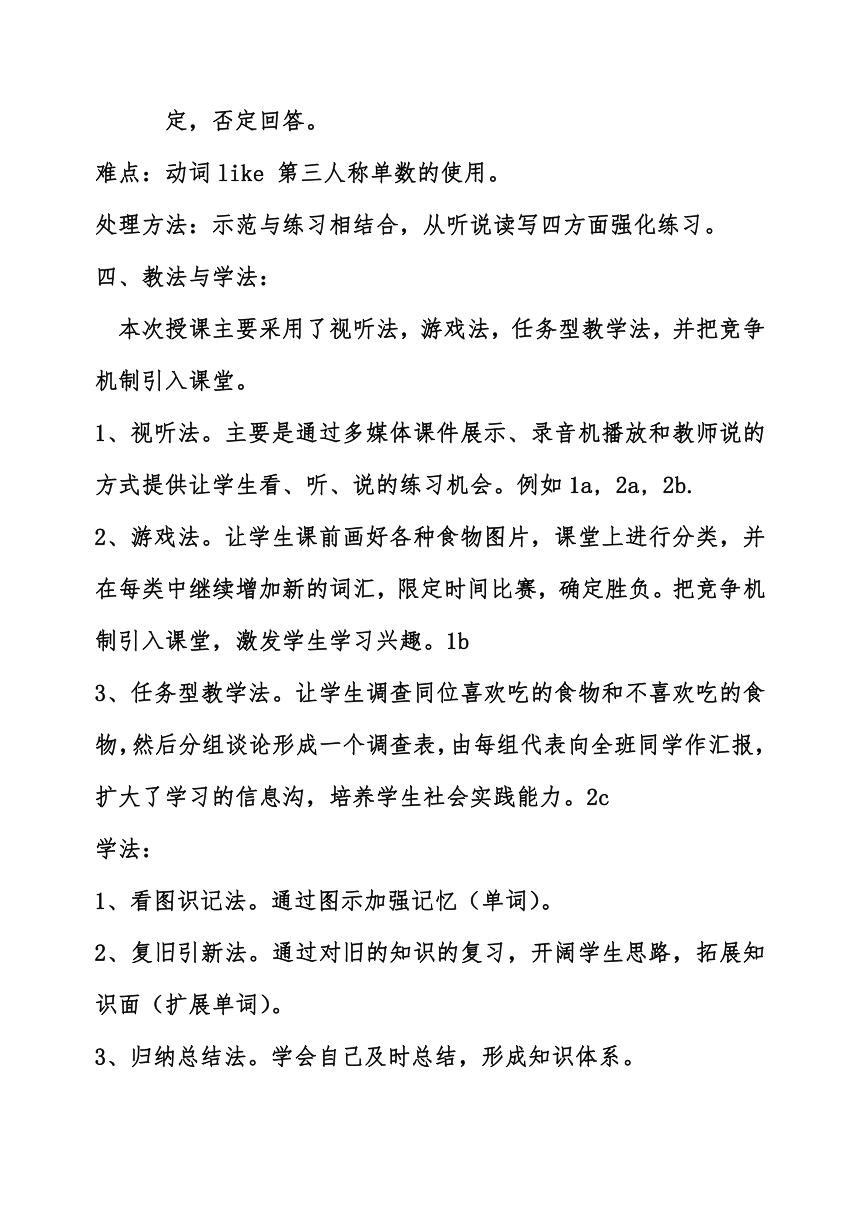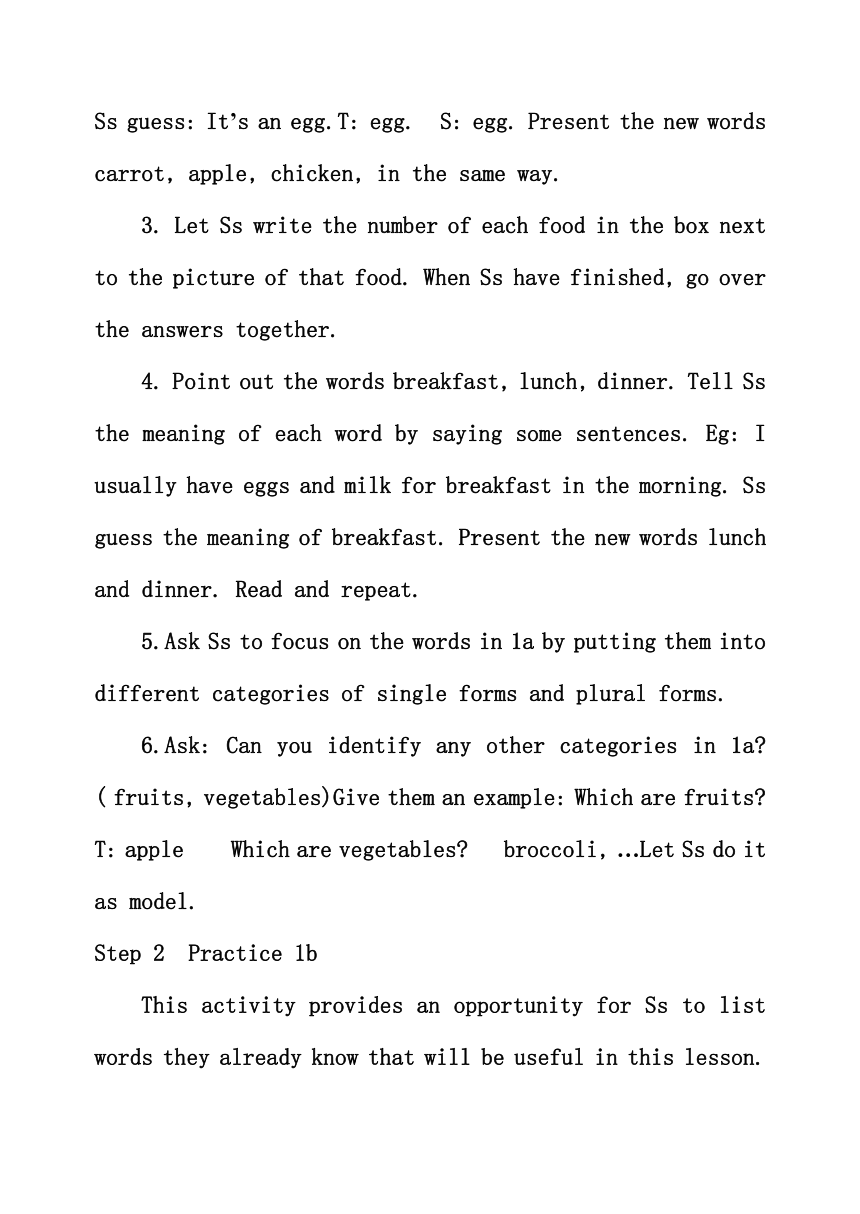Unit 6 Do you like bananas? section B 1a-2c [上学期]
文档属性
| 名称 | Unit 6 Do you like bananas? section B 1a-2c [上学期] |  | |
| 格式 | rar | ||
| 文件大小 | 9.8KB | ||
| 资源类型 | 教案 | ||
| 版本资源 | 人教新目标(Go for it)版 | ||
| 科目 | 英语 | ||
| 更新时间 | 2008-08-01 19:37:00 | ||
图片预览





文档简介
Unit 6
Do you like bananas
Unit 6 Do you like bananas
第三课时 Section B 1a-2c
一、教材分析及设计思路。
Unit 6以食物为载体Talk about likes and dislikes。语言目标是动词like 的用法,一般疑问句的肯定回答和否定回答,名词复数的使用。运用的主要句型有:Do you like… .和 Does she/he like … 及肯定回答和否定回答。这一语法功能在Unit5和Unit9-12都是重点,本单元在整个教材中起着承上启下的作用。本单元共分四个课时,SectionA为第一、二课时,为目标句型提供了分步示例和指导性练习,SectionB1a-2c为第三课时,剩下的内容为第四课时,我今天要讲的是第三课时,这一课主要是对SectionA目标语言的扩展和灵活运用,为下一课时及Unit9打好基础。是Section A的扩展和新旧语言知识的综合运用。
设计思路:
根据以上对教材的分析,和本课时在本单元中的地位,在掌握本课重点词汇的基础上,努力扩展词汇量,例如1b中的add to the lists.通过词汇来反复练习句型。为了激发学生学习兴趣,从听、说、读、写四个方面为学生设置各项小任务,例如:记单词比赛,单词分类,听力练习,阅读训练,对话表演等,使学生在完成这些任务的一系列活动中,掌握知识。补充材料为分级阅读P60 A。
二、教学目标:(知识目标、能力目标、德育目标)
知识目标:
(1)学习、掌握重点词汇。(eggs, apples, carrots, chicken, fruit, vegetable, breakfast, lunch, dinner.)
(2)学习使用句型Do you like… Does he/she like… 询问对方和他人喜欢与不喜欢的食物。
能力目标:学会对名词进行分类;学会表达及询问他人对事物的喜好;能阅读相应内容的文章。
德育目标:提高学生学习英语的兴趣,并使学生初步学会均衡饮食。
兴趣,为进一步学习打好初步的基础。
三、重点与难点及处理方法:
重点:有关食物的重点词汇和动词like的用法,一般疑问句及肯定,否定回答。
难点:动词like 第三人称单数的使用。
处理方法:示范与练习相结合,从听说读写四方面强化练习。
四、教法与学法:
本次授课主要采用了视听法,游戏法,任务型教学法,并把竞争机制引入课堂。
1、视听法。主要是通过多媒体课件展示、录音机播放和教师说的方式提供让学生看、听、说的练习机会。例如1a, 2a, 2b.
2、游戏法。让学生课前画好各种食物图片,课堂上进行分类,并在每类中继续增加新的词汇,限定时间比赛,确定胜负。把竞争机制引入课堂,激发学生学习兴趣。1b
3、任务型教学法。让学生调查同位喜欢吃的食物和不喜欢吃的食物,然后分组谈论形成一个调查表,由每组代表向全班同学作汇报,扩大了学习的信息沟,培养学生社会实践能力。2c
学法:
1、看图识记法。通过图示加强记忆(单词)。
2、复旧引新法。通过对旧的知识的复习,开阔学生思路,拓展知识面(扩展单词)。
3、归纳总结法。学会自己及时总结,形成知识体系。
4、讨论演示法。通过学生自己讨论,形成完整的对话,表演给其他同学看,即学习了语言又锻炼了能力,达到了任务型教学的目的。
五、教学手段:
主要以现代化电教手段--多媒体辅助教学,贯穿整个教学过程。增加了直观性和趣味性,加大了课堂密度,提高了教学效果。
六、教学原则:
从学生的学习兴趣、生活经验和认知水平出发,倡导体验、实践、参与、合作与交流的学习方式和任务性的教学途径,发展学生的语言综合运用能力。遵循的原则:
1、发展性和拓展性原则。2、科学性原则。3、趣味性原则。4、灵活性和开放性原则。
七、教学过程
Step 1 Revision
This activity gives Ss a chance to revise the words presented in Section A and learn some more food names.
1.Show some pictures on multimedia, The teacher points to each picture, let Ss read and spell the food name of the picture out one by one. Provide pronunciation support.
2.The teacher points to one picture of egg. T: What’s this Ss guess: It’s an egg.T: egg. S: egg. Present the new words carrot, apple, chicken, in the same way.
3. Let Ss write the number of each food in the box next to the picture of that food. When Ss have finished, go over the answers together.
4. Point out the words breakfast, lunch, dinner. Tell Ss the meaning of each word by saying some sentences. Eg: I usually have eggs and milk for breakfast in the morning. Ss guess the meaning of breakfast. Present the new words lunch and dinner. Read and repeat.
5.Ask Ss to focus on the words in 1a by putting them into different categories of single forms and plural forms.
6.Ask: Can you identify any other categories in 1a ( fruits, vegetables)Give them an example: Which are fruits T: apple Which are vegetables broccoli, …Let Ss do it as model.
Step 2 Practice 1b
This activity provides an opportunity for Ss to list words they already know that will be useful in this lesson. By sharing these words, Ss can learn useful language from each other.
1. Ask Ss work in pairs. Discuss the difference between a fruit and a vegetable .
2. Set a time limit of three minutes. Ask them to list as many fruits and vegetables as they can. They can discuss in pairs.
3. Ask one leader from each group to come to the board to write their list on it. Have a competition, see which group is the best one. The best group will get a flower or a star.
Step 3 Listening. 2a,2b
This activity helps Ss recognize and understand the words when they hear them in conversation.
1. Let Ss read the words in 1a again. Check that Ss understand the meaning of each word.
2. Play the recording for the first time. Ss only listen.
3. T: You will circle only seven of the ten words. Play again. Ss circle the seven items they hear. Check the answers.
4. 2b Ask Ss to look at the chart and the sample answers. T: There are four answer boxes for each person. The boxes in column 1 are for foods the person likes. The boxes in column 2 are for foods the person doesn’t like.
5. Play the recording again. Ss write the food names in the chart.
6. Play the recording again, stopping after each line to check the answers.
Step 4 Reading
This activity provides guided reading practice using the target language.
Use the classification reading book P60 A.
Ask Ss a Pre-reading question: What do you like eating for breakfast, lunch or dinner
Get the Ss to skim what they will read about. Then have them read for detail.
Do exercise 1
Step 5 Practice
This activity provides guided oral practice using the target language.
1. Point out the speech bubbles and ask two Ss to read them aloud.
2. Then point to the chart and call on two Ss. T: Ask and answer another question using information from the chart. As Ss ask and answer questions, move around the class room offering language support as needed.
3. Then point to the completed chart in 2b and say, Look at the foods each person likes. Look at the foods each person doesn’t like. Now decide who each meal belongs to. They can discuss. Check the answers.
Step 6 Drill
This activity gives Ss practice in talking the target language from units 1-5.
1. Have Ss divide into 8 groups work in pairs. Talk to your partner about some of the food she/ he likes to eat.
2. Ss then practice the conversation in pairs using their own information.
3. Tell pairs of Ss : Say your conversations for the class, see which one is the best.
Homework:
1.Listen to the recording and then make a similar conversation using their own information.
2.Talk to your partner about some of the food she/ he likes to eat at each meal and make a list of the food your partner mentions. Please write at least three kinds of food for each meal.
板书设计
Do you like bananas Do you like … Yes, I do. New words No, I don’t. egg, apple, carrot, Does he/she like … chicken, fruit, vegetable Yes, he/she does. breakfast, lunch, dinner No, he/she doesn’t. (划线字母强调音标)
课后记:
本堂课学生对单词的掌握较好,90%的学生能当堂记住,重点句型:Do you like … 运用熟练,对第三人称单数的运用也达到了预期的效果,在对话练习中,学生出错较少,听力练习98%以上的学生都能作对,课堂气氛活跃,教学效果良好,体现了以学生为主体的教学宗旨。存在不足:部分学生口语水平较差,需加强练习,学生板书不很规范,应加以指导。
Do you like bananas
Unit 6 Do you like bananas
第三课时 Section B 1a-2c
一、教材分析及设计思路。
Unit 6以食物为载体Talk about likes and dislikes。语言目标是动词like 的用法,一般疑问句的肯定回答和否定回答,名词复数的使用。运用的主要句型有:Do you like… .和 Does she/he like … 及肯定回答和否定回答。这一语法功能在Unit5和Unit9-12都是重点,本单元在整个教材中起着承上启下的作用。本单元共分四个课时,SectionA为第一、二课时,为目标句型提供了分步示例和指导性练习,SectionB1a-2c为第三课时,剩下的内容为第四课时,我今天要讲的是第三课时,这一课主要是对SectionA目标语言的扩展和灵活运用,为下一课时及Unit9打好基础。是Section A的扩展和新旧语言知识的综合运用。
设计思路:
根据以上对教材的分析,和本课时在本单元中的地位,在掌握本课重点词汇的基础上,努力扩展词汇量,例如1b中的add to the lists.通过词汇来反复练习句型。为了激发学生学习兴趣,从听、说、读、写四个方面为学生设置各项小任务,例如:记单词比赛,单词分类,听力练习,阅读训练,对话表演等,使学生在完成这些任务的一系列活动中,掌握知识。补充材料为分级阅读P60 A。
二、教学目标:(知识目标、能力目标、德育目标)
知识目标:
(1)学习、掌握重点词汇。(eggs, apples, carrots, chicken, fruit, vegetable, breakfast, lunch, dinner.)
(2)学习使用句型Do you like… Does he/she like… 询问对方和他人喜欢与不喜欢的食物。
能力目标:学会对名词进行分类;学会表达及询问他人对事物的喜好;能阅读相应内容的文章。
德育目标:提高学生学习英语的兴趣,并使学生初步学会均衡饮食。
兴趣,为进一步学习打好初步的基础。
三、重点与难点及处理方法:
重点:有关食物的重点词汇和动词like的用法,一般疑问句及肯定,否定回答。
难点:动词like 第三人称单数的使用。
处理方法:示范与练习相结合,从听说读写四方面强化练习。
四、教法与学法:
本次授课主要采用了视听法,游戏法,任务型教学法,并把竞争机制引入课堂。
1、视听法。主要是通过多媒体课件展示、录音机播放和教师说的方式提供让学生看、听、说的练习机会。例如1a, 2a, 2b.
2、游戏法。让学生课前画好各种食物图片,课堂上进行分类,并在每类中继续增加新的词汇,限定时间比赛,确定胜负。把竞争机制引入课堂,激发学生学习兴趣。1b
3、任务型教学法。让学生调查同位喜欢吃的食物和不喜欢吃的食物,然后分组谈论形成一个调查表,由每组代表向全班同学作汇报,扩大了学习的信息沟,培养学生社会实践能力。2c
学法:
1、看图识记法。通过图示加强记忆(单词)。
2、复旧引新法。通过对旧的知识的复习,开阔学生思路,拓展知识面(扩展单词)。
3、归纳总结法。学会自己及时总结,形成知识体系。
4、讨论演示法。通过学生自己讨论,形成完整的对话,表演给其他同学看,即学习了语言又锻炼了能力,达到了任务型教学的目的。
五、教学手段:
主要以现代化电教手段--多媒体辅助教学,贯穿整个教学过程。增加了直观性和趣味性,加大了课堂密度,提高了教学效果。
六、教学原则:
从学生的学习兴趣、生活经验和认知水平出发,倡导体验、实践、参与、合作与交流的学习方式和任务性的教学途径,发展学生的语言综合运用能力。遵循的原则:
1、发展性和拓展性原则。2、科学性原则。3、趣味性原则。4、灵活性和开放性原则。
七、教学过程
Step 1 Revision
This activity gives Ss a chance to revise the words presented in Section A and learn some more food names.
1.Show some pictures on multimedia, The teacher points to each picture, let Ss read and spell the food name of the picture out one by one. Provide pronunciation support.
2.The teacher points to one picture of egg. T: What’s this Ss guess: It’s an egg.T: egg. S: egg. Present the new words carrot, apple, chicken, in the same way.
3. Let Ss write the number of each food in the box next to the picture of that food. When Ss have finished, go over the answers together.
4. Point out the words breakfast, lunch, dinner. Tell Ss the meaning of each word by saying some sentences. Eg: I usually have eggs and milk for breakfast in the morning. Ss guess the meaning of breakfast. Present the new words lunch and dinner. Read and repeat.
5.Ask Ss to focus on the words in 1a by putting them into different categories of single forms and plural forms.
6.Ask: Can you identify any other categories in 1a ( fruits, vegetables)Give them an example: Which are fruits T: apple Which are vegetables broccoli, …Let Ss do it as model.
Step 2 Practice 1b
This activity provides an opportunity for Ss to list words they already know that will be useful in this lesson. By sharing these words, Ss can learn useful language from each other.
1. Ask Ss work in pairs. Discuss the difference between a fruit and a vegetable .
2. Set a time limit of three minutes. Ask them to list as many fruits and vegetables as they can. They can discuss in pairs.
3. Ask one leader from each group to come to the board to write their list on it. Have a competition, see which group is the best one. The best group will get a flower or a star.
Step 3 Listening. 2a,2b
This activity helps Ss recognize and understand the words when they hear them in conversation.
1. Let Ss read the words in 1a again. Check that Ss understand the meaning of each word.
2. Play the recording for the first time. Ss only listen.
3. T: You will circle only seven of the ten words. Play again. Ss circle the seven items they hear. Check the answers.
4. 2b Ask Ss to look at the chart and the sample answers. T: There are four answer boxes for each person. The boxes in column 1 are for foods the person likes. The boxes in column 2 are for foods the person doesn’t like.
5. Play the recording again. Ss write the food names in the chart.
6. Play the recording again, stopping after each line to check the answers.
Step 4 Reading
This activity provides guided reading practice using the target language.
Use the classification reading book P60 A.
Ask Ss a Pre-reading question: What do you like eating for breakfast, lunch or dinner
Get the Ss to skim what they will read about. Then have them read for detail.
Do exercise 1
Step 5 Practice
This activity provides guided oral practice using the target language.
1. Point out the speech bubbles and ask two Ss to read them aloud.
2. Then point to the chart and call on two Ss. T: Ask and answer another question using information from the chart. As Ss ask and answer questions, move around the class room offering language support as needed.
3. Then point to the completed chart in 2b and say, Look at the foods each person likes. Look at the foods each person doesn’t like. Now decide who each meal belongs to. They can discuss. Check the answers.
Step 6 Drill
This activity gives Ss practice in talking the target language from units 1-5.
1. Have Ss divide into 8 groups work in pairs. Talk to your partner about some of the food she/ he likes to eat.
2. Ss then practice the conversation in pairs using their own information.
3. Tell pairs of Ss : Say your conversations for the class, see which one is the best.
Homework:
1.Listen to the recording and then make a similar conversation using their own information.
2.Talk to your partner about some of the food she/ he likes to eat at each meal and make a list of the food your partner mentions. Please write at least three kinds of food for each meal.
板书设计
Do you like bananas Do you like … Yes, I do. New words No, I don’t. egg, apple, carrot, Does he/she like … chicken, fruit, vegetable Yes, he/she does. breakfast, lunch, dinner No, he/she doesn’t. (划线字母强调音标)
课后记:
本堂课学生对单词的掌握较好,90%的学生能当堂记住,重点句型:Do you like … 运用熟练,对第三人称单数的运用也达到了预期的效果,在对话练习中,学生出错较少,听力练习98%以上的学生都能作对,课堂气氛活跃,教学效果良好,体现了以学生为主体的教学宗旨。存在不足:部分学生口语水平较差,需加强练习,学生板书不很规范,应加以指导。
同课章节目录
- starters 预备篇(2012秋审查)
- Unit 1 Good morning !
- Unit 2 What’s this in English?
- Unit 3 What color is it ?
- Unit 1 My name's Gina.
- Section A
- Section B
- Unit 2 This is my sister.
- Section A
- Section B
- Unit 3 Is this your pencil?
- Section A
- Section B
- Unit 4 Where's my schoolbag?
- Section A
- Section B
- Unit 5 Do you have a soccer ball?
- Section A
- Section B
- Unit 6 Do you like bananas?
- Section A
- Section B
- Unit 7 How much are these socks?
- Section A
- Section B
- Unit 8 When is your birthday?
- Section A
- Section B
- Unit 9 My favorite subject is science.
- Section A
- Section B
